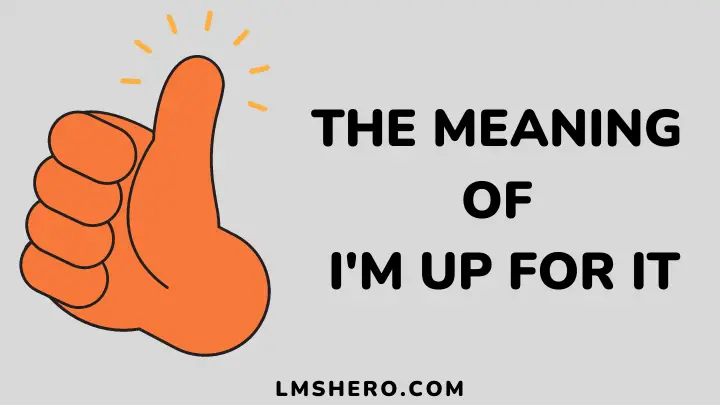In today’s ever-evolving language landscape, colloquial phrases are vital to communication. One such phrase that has gained popularity over time is “I’m up for it.”
This expression is commonly used in casual conversations, but its true meaning might not be immediately apparent to everyone. In this article, I will delve into the depths of “I’m up for it” to explore its different interpretations, contexts, and usage.
So, if you’ve ever wondered what someone means when they say, “I’m up for it,” you’re in the right place.
Understanding the phrase
The expression “I’m up for it” is a casual way of showing eagerness or willingness to be involved in a specific task, event, or challenge.
It is commonly used to indicate preparedness and willingness to participate in something. Although the meaning may appear clear, there are intricacies and subtleties to its application that I will delve into in this article.
Origins and evolution
The phrase “I’m up for it” has its roots in informal English language usage and has since become a widely used idiomatic expression in various English-speaking regions.
As language changes, so does the meaning and application of phrases like “I’m up for it.” Let’s delve deeper into how this expression has developed and gained significance in modern conversations.
Exploring different interpretations
While the literal meaning of “I’m up for it” suggests an affirmative response to a proposition, the phrase can have multiple interpretations depending on the context and tone.
It can convey a sense of excitement, interest, agreement, or even determination. Understanding the underlying message behind the words is crucial for effective communication.
Examples of “I’m Up for It” in Conversations
To further illustrate the usage of “I’m up for it,” let’s explore some examples:
Example 1:
Person A: “Hey, there’s a hiking trip this weekend. Are you up for it?”
Person B: “Absolutely! I’m up for it. Count me in!”
Example 2:
Person A: “We’re starting a book club. Would you like to join?”
Person B: “I’m definitely up for it. I love reading and discussing books.”
Example 3:
Person A: “We’re organizing a charity event. Can you help?”
Person B: “I’m up for it! Let me know how I can contribute.”
The importance of body language
When someone says, “I’m up for it,” nonverbal cues such as facial expressions, gestures, and tone of voice can help determine their enthusiasm and commitment. When telling someone, “I’m up for it,” your body language can be just as important as your words.
Eye contact, a firm handshake, and an upright posture convey confidence and enthusiasm, making the person you’re speaking to more likely to believe in your abilities.
On the other hand, slouching, avoiding eye contact, or fidgeting can all signal uncertainty or disinterest, potentially harming your chances of success. Remember to use body language to your advantage when communicating your readiness for a task or opportunity.
These subtle indicators play an essential role in grasping the true meaning behind the words.
Tips for incorporating “I’m up for it” in your conversations

To use the phrase “I’m up for it” effectively in your conversations, consider the following tips:
- Be enthusiastic: Use the phrase genuinely to convey your willingness to participate.
- Use appropriate body language: Accompany the phrase with positive gestures and facial expressions to reinforce your eagerness.
- Tailor your response: Modify your response based on the specific context to show your interest and commitment.
- Be open-minded: Embrace new experiences and challenges by using the phrase to express your readiness to explore.
Common misinterpretations
While saying “I’m up for it” can be a sign of willingness and readiness to take on a challenge, it can also be easily misinterpreted. Some may mistake it as a sign of overconfidence or a lack of understanding of the risks involved.
Others may take advantage of your eagerness and push you beyond your limits. It’s important to clearly communicate your abilities and limitations and weigh the consequences before committing to anything.
Don’t be afraid to ask for help or to decline if it’s not a wise decision for your well-being.
FAQs
How can you determine if someone genuinely means “I’m up for it”?
Pay attention to their enthusiasm, body language, and follow-through. Genuine enthusiasm is often reflected in their tone, facial expressions, and willingness to take action.
Are there any alternative phrases that convey a similar meaning?
Yes, there are several alternatives, such as “Count me in,” “I’m game,” or “I’m ready to go.” These phrases express a similar willingness and enthusiasm to participate.
What are the cultural differences in interpreting “I’m up for it”?
Cultural differences can influence the interpretation of “I’m up for it.” In some cultures, directness, and enthusiasm are valued, while in others, more subtle expressions may be preferred. It’s important to consider the cultural context when interpreting this phrase.
Can body language help understand the true intention behind “I’m up for it”?
Body language plays a significant role in understanding the true intention behind “I’m up for it.” Positive body language, such as smiling, nodding, and open gestures, can indicate genuine enthusiasm and willingness.
Are there situations where “I’m up for it” might carry a negative connotation?
While “I’m up for it” generally conveys a positive willingness, it can carry a negative connotation if used sarcastically or reluctantly. Tone and context are important factors in determining whether the phrase has a negative undertone.
Conclusion
In conclusion, “I’m up for it” is a widely used expression that conveys enthusiasm, willingness, and readiness to engage in or participate in something. It has evolved from informal usage to an integral part of everyday conversations.
By understanding the meaning and cultural significance of “I’m up for it,” you can effectively incorporate it into your interactions and embrace new experiences with a positive and adventurous mindset.
Learn more about the omega symbol meaning.
Thanks for reading.






